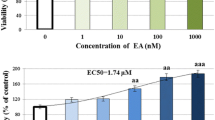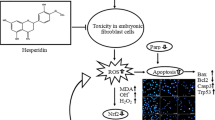Abstract
This study was conducted to evaluate the cytoprotective activity of roasted coffee residues (RCRs) extract on mouse embryonic fibroblast (MEF) cells. RCRs originated from Colombia and Honduras are relatively nontoxic to cell growth and even stimulate cell proliferation. Colombian RCRs showed most efficient protective effects on MEF cells against oxidative damage induced by H2O2 compared among the extracts prepared under the same roasting time. The most significant radical scavenging activity was measured in RCR with roasting time of 8.5 min. Phenolic and nonphenolic compounds in RCRs were chlorogenic acid, caffeine, caffeic acid, nicotinic acid, trigonelline, and 5-(hydroxymethyl)furfuralolehyde. Effect of Colombian RCRs on apoptosis occurred by oxidative damage was evaluated by morphological and flow cytometric analysis. Apoptotic cell accumulation was decreased by cotreatment of MEF cells with Colombian RCRs. These results suggested that antioxidant potency of RCRs suppresses the cytotoxicity which is induced by H2O2 and has a protective effect on MEF cell against oxidative stress.
Similar content being viewed by others
References
Villanueva CM, Cantor KP, King WD, Jaakkola JJ, Cordier S, Lynch CF, Porru S, Kogevinas M. Total and specific fluid consumption as determinants of bladder cancer risk. Int. J. Cancer 118: 2040–2047 (2006)
Higdon JV, Frei B. Coffee and health: A review of recent human research. Crit. Rev. Food Sci. 46: 101–123 (2006)
Bonita JS, Mandarano M, Shuta D, Vinson J. Coffee and cardiovascular disease: in vitro, cellular, animal, and human studies. Pharmacol. Res. 55: 187–198 (2007)
Ross GW, Abbott RD, Petrovitch H, Morens DM, Grandinetti A, Tung KH, Tanner CM, Masaki KH, Blanchette PL, Curb JD, Popper JS, White LR. Association of coffee and caffeine intake with the risk of Parkinson disease. J. Am. Med. Assoc. 283: 2674–2679 (2000)
Tavani, A, Bertuzzi M, Talamini R, Gallus S, Parpinel M, Franceschi S, Levi F, La Vecchia C. Coffee and tea intake and risk of oral, pharyngeal, and esophageal cancer. Oral Oncol. 39: 695–700 (2003)
Wang Y, Ho CT. Polyphenolic chemistry of tea and coffee: A century of progress. J. Agr. Food Chem. 57: 8109–8114 (2009)
Rice-Evans CA, Miller NJ, Paganga G. Structure-antioxidant activity relationships of flavonoids and phenolic acids. Free Radical Bio. Med. 20: 933–956 (1996)
Nunomura A, Perry G, Aliev G, Hirai K, Takeda A, Balraj EK, Jones PK, Ghanbari H, Wataya T, Shimohama S, Chiba S, Atwood CS, Petersen RB, Smith MA. Oxidative damage is the earliest event in Alzheimer disease. J. Neuropath. Exp. Neur. 60: 759–767 (2001)
Good PF, Werner P, Hsu A, Olanow CW, Perl DP. Evidence for neuronal oxidative damage in Alzheimer’s disease. Am. J. Pathol. 149: 21–28 (1996)
Minamisawa M, Yoshida S, Takai N. Determination of biologically active substances in roasted coffees using a diode-array HPLC system. Anal. Sci. 20: 325–328 (2004)
Moon J-K, Yoo HS, Shibamoto T. Role of roasting conditions in the level of chlorogenic acid content in coffee beans: Correlation with coffee acidity. J. Agr. Food Chem. 57: 5365–5369 (2009)
Yen WJ, Wang BS, Chang LW, Duh PD. Antioxidant properties of roasted coffee residues. J. Agr. Food Chem. 53: 2658–2663 (2005)
Casal S, Oliveira MB, Alves MR, Ferreira MA. Discriminate analysis of roasted coffee varieties for trigonelline, nicotinic acid, and caffeine content. J. Agr. Food Chem. 48: 3420–3424 (2000)
Rucinska A, Gabryelak T. Effect of genistein-8-C-glucoside from Lupinus luteus on DNA damage assessed using the comet assay in vitro. Cell Biol. Int. 33: 247–252 (2009)
Stoner GD, Mukhtar H. Polyphenols as cancer chemopreventive agents. J. Cell Biochem. 22: 169–180 (1995)
Ha JY, Goo SY, Sung JS, Shin HS. Antioxidant and cytoprotective activity of the olive leaf (Olea europaea L. var. Kalamata) extracts on the mouse embryonic fibroblast cell. Food Sci. Biotechnol. 18: 964–970 (2009)
Adrian J, Frangne R. Synthesis and availability of niacin in roasted coffee. Adv. Exp. Med. Biol. 289: 49–59 (1991)
Benhar M, Engelberg D, Levizki A. ROS, stress-activated kinases and stress signaling in cancer. EMBO Rep. 3: 420–425 (2002)
Valko M, Leibfritz D, Moncol J, Cronin MT, Mazur M, Telser J. Free radicals and antioxidants in normal physiological functions and human disease. Int. J. Biochem. Cell B. 39: 44–84 (2007)
Molyneux P. The use of the stable free radial diphenylpicryl-hydrazyl (DPPH) for estimating antioxidant activity. Songklanakarin J. Sci. Technol. 26: 211–219 (2004)
Limón-Pacheco J, Gonsebatt ME. The role of antioxidants and antioxidant-related enzymes in protective responses to environmentally induced oxidative stress. Mutat. Res. 674: 137–147 (2009)
Niwano Y, Saito K, Yoshizaki F, Kohno M, Ozawa T. Extensive screening for herbal extracts with potent antioxidant properties. J. Clin. Biochem. Nutr. 48: 78–84 (2011)
Bekedam EK, Schols HA, Cammerer B, Kroh LW, van Boekel MA, Smit G. Electron spin resonance (ESR) studies on the formation of roasting-induced antioxidative structures in coffee brews at different degrees of roast. J. Agr. Food Chem. 56: 4597–4604 (2008)
Moon JK, Shibamoto T. Role of roasting conditions in the profile of volatile flavor chemicals formed from coffee beans. J. Agr. Food Chem. 57: 5823–5831 (2009)
Li YX, Li Y, Qian ZJ, Kim MM, Kim SK. In vitro antioxidant activity of 5-HMF isolated from marine red alga Laurencia undulate in free-radical-mediated oxidative systems. J. Microbiol. Biotechn. 19: 1319–1327 (2009)
del Castillo MD, Ames JM, Gordon MH. Effect of roasting on the antioxidant activity of coffee brews. J. Agr. Food Chem. 50: 3698–3703 (2002)
Anderson AJ, Su JH, Cotman CW. DNA damage and apoptosis in Alzheimer’s disease: Colocalization with c-Jun immunoreactivity, relationship to brain area, and effect of postmortem delay. J. Neurosci. 16: 1710–1719 (1996)
Lev N, Melamed E, Offen D. Apoptosis and Parkinson’s disease. Prog. Neuro. -Psychoph. 27: 245–250 (2003)
Buttke TM, Sandstrom PA. Oxidative stress as a mediator of apoptosis. Immunol. Today 15: 7–10 (1994)
Kang KA, Lee KH, Chae S, Zhang R, Jung MS, Kim SY, Kim HS, Kim DH, Hyun JW. Cytoprotective effect of tectorigenin, a metabolite formed by transformation of tectoridin by intestinal microflora, on oxidative stress induced by hydrogen peroxide. Eur. J. Pharmacol. 519: 16–23 (2005)
Author information
Authors and Affiliations
Corresponding author
Rights and permissions
About this article
Cite this article
Sung, JS., Go, EB. & Shin, HS. Cytoprotective activity of extract of roasted coffee residue on mouse embryonic fibroblasts cells against apoptosis induced by oxidative stress. Food Sci Biotechnol 21, 137–143 (2012). https://doi.org/10.1007/s10068-012-0017-1
Received:
Revised:
Accepted:
Published:
Issue Date:
DOI: https://doi.org/10.1007/s10068-012-0017-1




